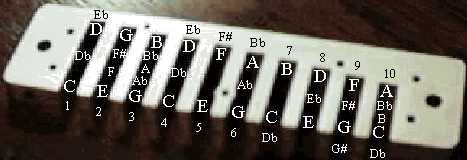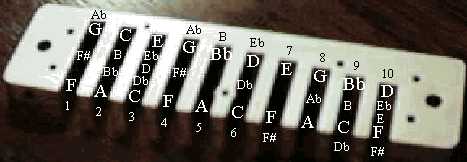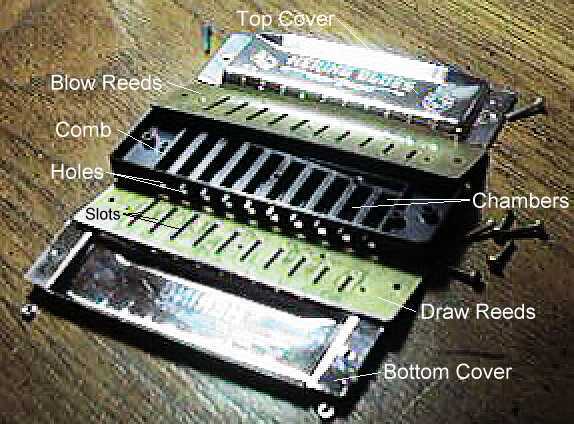How to bend a note on Harmonica? Bending Tips
How to bend a note on Harmonica? Bending is a basic diatonic harmonica playing technique used to produce notes not otherwise available in the basic tuning of the harp, and they are also used to provide various sliding-note effects. Bends are, in large part, what give the diatonic harp its unique character, and are intimately related to the blues tradition.
Bending, whether draw bends or blow bends, produce notes lower in pitch than the natural, unbent note. The amount you can bend a note depends on the pitches of the two reeds in the hole. The higher pitch note in the hole can be bent down to just below a half step above the lower pitch note in the hole.
For example, the notes on a C harp in hole 2 are: blow-E, draw-G. The higher G note can be bent down to Gb and F–and just a little lower. It is best to only bend down to the desired note, and not further, in order to minimize stress on the reeds. You can use a piano, guitar, pitch pipe, or electronic tuner to check that you’re hitting the correct pitch.
Bending is not something that is easy to describe how to do–and it is difficult to show because all the movements are hidden inside the mouth and throat. It takes practice to be able to do bends at all, and lots more practice to do them well. There are draw bends available on holes 1 through 6, and blow bends available on holes 7 through 10, each of which require different playing techniques.
To make matters more challenging, different key harps require different bending techniques, depending on the pitch range of the harp. Lower key harps (e.g. A, Ab, G, and low F) require more mouth/throat/tongue movement than the same holes on higher key harps (e.g. C, D, E, and F).
Bends are intially quite challenging–but they are quite fun, and eventually become second nature. Learning your bends not only gives you more notes and effects, it gives you more control over your notes, air stream, resonance, and tone.
So, celebrate when you finally get your first bends! But remember–that’s only the beginning!
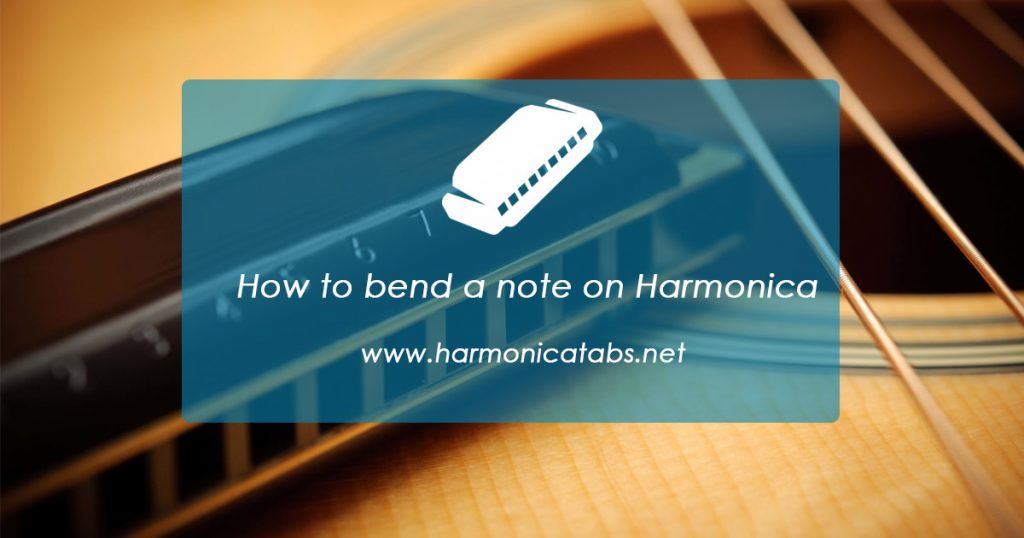
How to bend a note on Harmonica?
[toc]
What is a bend?
Bending allows us to play notes that wouldn’t be available otherwise. Diatonic harmonicas have several missing notes (tones in the musicial scale that don’t appear naturally on the instrument) so bending helps us to fill in these gaps.
Bends are a distinctive part of the blues sound. Bending works by making both the blow and draw reeds vibrate simultaneously to produce a note which sits between the pitch of each indivudal reed.
How do you get a bend?
Bending requires a change to the oral cavity (space in your mouth) to allow a lower note to resonate. This can take some getting used to. It feels silly at first, but practising moving the shape of your mouth from an ‘AH’ or ‘EE’ to an ‘OO’ shape is a good place to start:
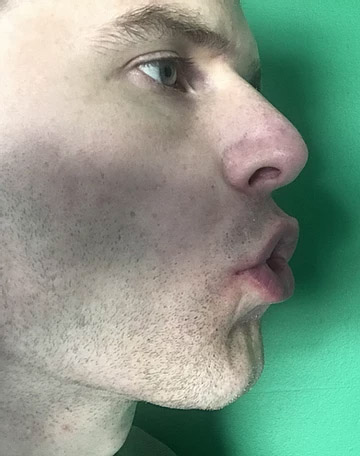
Now try sliding the tip of your tongue directly back in your mouth to create a humped shape. This helps angle the airflow so that both the blow and draw reed vibrate.
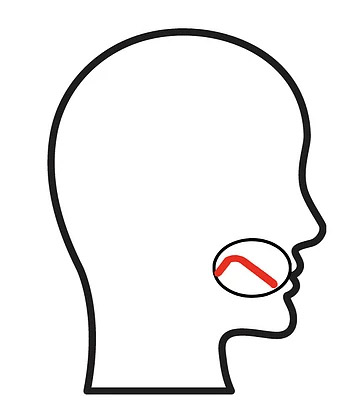
Finding the ‘sweet spot’
The two steps above are all that’s needed to achieve a bend, but it can take a frustratingly long time to make this work. You need to experiment with slow changes of shape and position to find the sweet spot where it comes together and the note moves.
When this happens, stay where you are! A couple of other ways to conceptualise the technique are (a) to say ‘KUH’ as you play a note, and (b) to think of playing an inward whistle which gets lower and lower.
Which notes will bend?
Holes 1-6 will bend on the draw notes. Holes 7-10 will bend on the blow notes. We tend to learn the draw bends first as they often come more easily (you’ll probably find hole 4 will work first). As you progress, you’ll learn to control these bends and use them as melodic notes. Here’s a diagram of the bends available on a C harmonica:
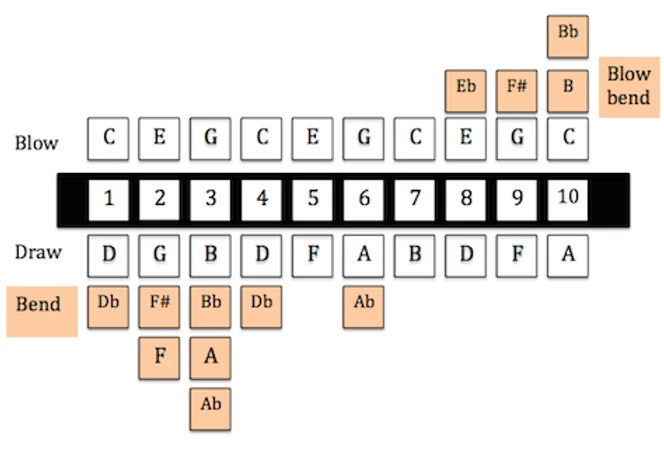
Note that each hole (and each key of harmonica) will feel different so you will need to adapt your technique to each situation. Good luck!
Draw Bends
Draw bends are available on holes 1 through 6–but hole 5 will not bend as much as a full half step. Don’t try to bend lower than the note will go or you risk damaging the reeds.
Here are some tips for getting your first draw bends.
- First, be sure you can get a good, clean, pure, loud, single note before going any further!
Don’t even worry about bends if you can’t get a consistent pure single note.
- One good approach is to use the “lip block” embouchure. It helps you relax and get your mouth open, which helps improve your resonance and makes bending easier.
- While breathing in from your diaphragm, make “eeeeee” and “oooooh” sounds. Notice how your jaw drops on the “ooh” sound, and pay attention to the feeling in your throat. The bend happens when you go from “eeeeee” to “oooooh”.
Try holes 2, 3, and 4 for your first bends. The “Oh” should be deep with an open throat; try saying “orange”. Your throat should be like the first “or” part. Whisper it. Orange. Whisper it louder.
Whisper it breathing in. Try bending with the mouth/throat position of the “Or” part. - Make sure NO AIR leaks in through your nose. This is very important. If air leaks in through your nose it will be very very difficult to make the note bend.
- Make sure you have an air tight seal of your mouth on the harp. Air leaks get in the way of bends, whatever their cause.
- Don’t try to force it. Bending is essentially effortless. If your mouth/throat/tongue shape are right the bend will naturally happen. Think about holding an egg in your mouth during a bend. Keep playing with the shape of your mouth and your tongue position. Very minor changes in mouth/throat/tongue position make all the difference.
- Drop your draw and open up your vocal tract while continuting to draw air in smoothly–remember, don’t try to force it.
- Try whistling while breathing in. Bend the pitch of your whistled note down. That’s what it feels like to do draw bends.
- The tongue is the key (for beginners). Start with it flat and forward in your mouth. While drawing in with the “eeeee”, *slowly* pull it back, keeping the front low in the mouth, and humping it in the back. At some point the sound should begin to choke a little. That’s the crucial spot. Treat it like the “friction point” on a clutch car… if you move too fast you’ll stall the car–or miss the bend. At that crucial spot, adjust your mouth position from “eeee” to “ooooh”. At first, it may help to increase the air pressure a little. But, you don’t have to play loud or hard to get bends. You can bend notes playing quite softly.
- Breathe in while making a hard “K” sound. Notice where you make that sound in your throat. That’s one place in your vocal tract from which you can get a draw bend.
- Breathe from deep within your body–from your diaphragm. Feel your stomach push out a little bit. This will help your resonance and make bending easier. Lie on your back and slowly breathe in. Put your hand on your stomach and notice how it moves up and down–that’s the location of your diaphragm. Draw in your air from there.
- Try different key harps. The mouth position is different for different keys, and if you’re having trouble with one key another might work better. For example, if you can’t get it on a C harp, try an A harp or a D harp.
- As they say, “Practice, practice, practice…”
It ain’t as easy as it looks! Don’t give up! It takes a while to get it! And remember, don’t try it unless you can get consistent pure clean single notes–you have to master that first.
Blow Bends
Blow bends are normally learned after draw bends, because the low end of the harp (holes 1 through 6) are used more, especially by beginners, than the top end of the harp, holes 1 through 7, where the blow bends are available. Note that hole 7 will not bend as much as a full half step, so don’t try to force it or you could damage the reed.
Blow bends are done by constricting the air stream by tiny movements toward the front of the tongue.
Start the natural blow note with your tongue flat in the bottom of your mouth. Slowly, keeping the tongue flat, lift the tongue toward the roof of the mouth. Keep the air stream constant, and where you feel the note start to choke–that’s the crucial spot.
Very tiny changes to your tongue position cause the note to transition from the natural note to the bent note. You have to experiment and remember your exact mouth position. The vocal tract is more constricted in the mouth and throat for blow bends than for draw bends.
Try whistling a note and bending the pitch upwards. A similar tongue movement happens when doing blow bends on the harp.
5 tips for bending notes
- Move your mouth from an ‘AH’ to an ‘OO’ shape
- Drag your tongue back into a humped shape
- Say ‘KUH’ as you play a note
- Slurp the air instead of allowing it to travel freely
- Imagine an inward whistle that’s getting lower

